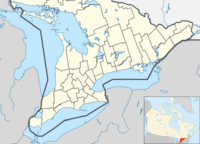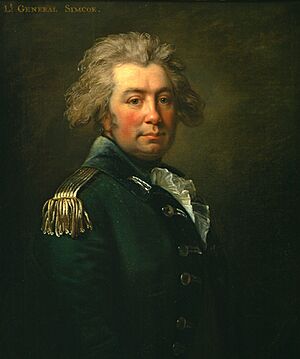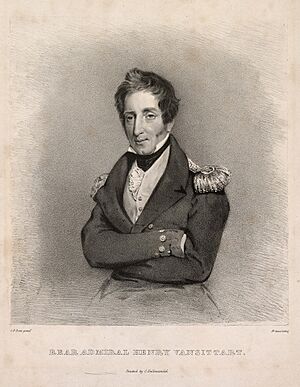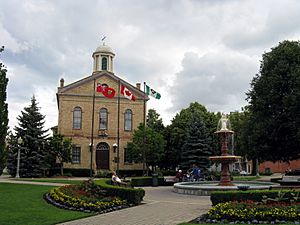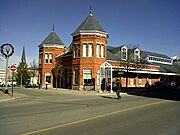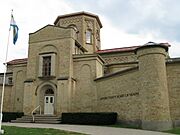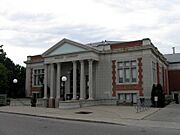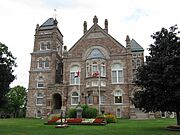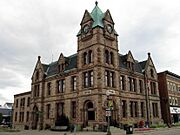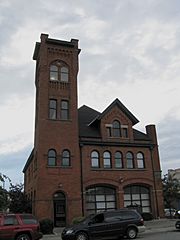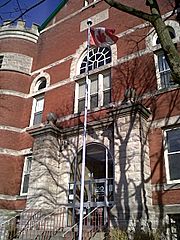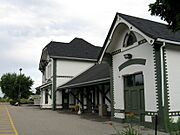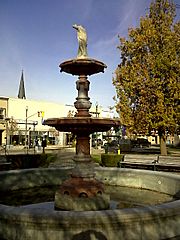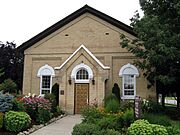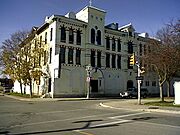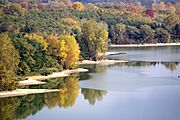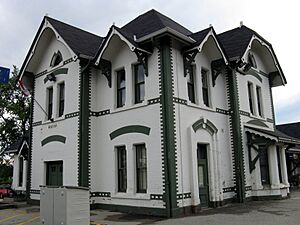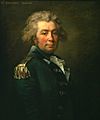Woodstock, Ontario facts for kids
Quick facts for kids
Woodstock
|
||
|---|---|---|
| City of Woodstock | ||

Woodstock City Hall
|
||
|
||
| Motto(s):
The Friendly City
|
||
| Country | Canada | |
| Province | Ontario | |
| County | Oxford | |
| Established | 1721 (as town) | |
| 1891 (city) | ||
| Area | ||
| • Total | 56.46 km2 (21.80 sq mi) | |
| Elevation | 300 m (1,000 ft) | |
| Population
(2021)
|
||
| • Total | 46,705 | |
| • Density | 827.2/km2 (2,142/sq mi) | |
| Time zone | UTC−5 (EST) | |
| • Summer (DST) | UTC−4 (EDT) | |
| Forward sortation area |
N4S to N4T
|
|
| Area code(s) | 519, 226, and 548 | |
| Website | www.cityofwoodstock.ca | |
Woodstock is a city in Southwestern Ontario, Canada. It's often called "The Friendly City" and is known as the Dairy Capital of Canada. The city is home to about 46,705 people, based on the 2021 Canadian census.
Woodstock is the main city in Oxford County. It's located near the start of the Thames River. It's about 128 kilometers from Toronto and 43 kilometers from London, Ontario.
The first European settlers arrived in Woodstock around 1800. It officially became a town in 1851. Woodstock has continued to grow steadily over the years. It's special because it's one of the few cities in Ontario that still has all its original government buildings.
Today, Woodstock is important for both manufacturing (making things in factories) and tourism. It also serves as a market for the farms around it. The city has a campus of Fanshawe College. You can also find many cultural and art spots here, like the Woodstock Museum.
Woodstock's west side has many beautiful old Victorian buildings. One famous street is Vansittart Avenue, named after an early settler, Admiral Henry Vansittart. The city also has a large community center. It has a big rink for hockey games and a hall for events.
Contents
- History of Woodstock
- Important Events in Woodstock's Past
- Woodstock's Climate
- Woodstock's Population and People
- Healthcare in Woodstock
- Woodstock's Sister Cities
- Culture and Fun in Woodstock
- Downtown Woodstock
- Historical Landmarks in Woodstock
- The Old Town Hall (Woodstock Museum)
- The Market Building
- Woodstock Jail (Gaol)
- Woodstock Public Library
- Oxford County Court House
- City Hall (Old Post Office)
- Old Fire Hall
- Woodstock Armoury
- Woodstock Via Station
- Pattulo's Fountain
- Old Registry Building
- Oxford Hotel
- Captain Andrew Drew House
- Hawkin's Chapel
- Hugh Richardson House
- James Hay Residence
- Perry-Hill Home; "House of the Valley"
- T.L. "Carbide" Willson House
- Kyrtleglen House
- Education in Woodstock
- Sports and Recreation in Woodstock
- Natural Areas and Parks
- Industries in Woodstock
- Transportation in Woodstock
- Media in Woodstock
- Notable People from Woodstock
- Images for kids
History of Woodstock
The area where Woodstock is now was first chosen as a good town spot in 1800. This decision was made by Sir John Graves Simcoe. He was the governor of what was then called Upper Canada.
Early settlers mainly came from New York state in the United States. Later, in the 1820s and 1830s, more people moved here from Great Britain. These new settlers included important figures like Admiral Henry Vansittart. He helped build one of the first churches in the area.
By 1836, about 200 people lived in Woodstock. This number grew to nearly 1,100 by 1846. The town had churches, a jail, a courthouse, and even two newspapers. There were also mills for grinding grain and sawing wood.
Woodstock officially became a town in 1851. Its first town meeting was held in a hotel. In 1901, with almost 9,000 people, Woodstock became a city.
From 1900 to 1920, electric streetcars ran through Woodstock. Later, in the 1920s, the main street was paved with bricks. These bricks were removed in the 1940s.
Important Events in Woodstock's Past
Premier Oliver Mowat's Time
Sir Oliver Mowat was a very important politician. He was from Kingston, Ontario. He served as a member of the provincial parliament for this region from 1872 to 1896. During this time, he was also the Premier of Ontario. A Premier is like the leader of the provincial government.
The 1979 Tornadoes
On August 7, 1979, three tornadoes hit the Woodstock area. Two of these were very strong, rated F4 on the Fujita scale. These tornadoes caused a lot of damage, especially on the west and south sides of town.
For example, a food store was badly damaged, and a flower shop was destroyed. A church also lost its roof. Luckily, no one on the street was seriously hurt, but it took many weeks to clean up the damage.
Woodstock's Climate
| Climate data for Woodstock (1981−2010) | |||||||||||||
|---|---|---|---|---|---|---|---|---|---|---|---|---|---|
| Month | Jan | Feb | Mar | Apr | May | Jun | Jul | Aug | Sep | Oct | Nov | Dec | Year |
| Record high °C (°F) | 18.3 (64.9) |
20.0 (68.0) |
25.0 (77.0) |
30.5 (86.9) |
35.0 (95.0) |
37.0 (98.6) |
38.9 (102.0) |
36.1 (97.0) |
37.2 (99.0) |
29.4 (84.9) |
22.8 (73.0) |
18.0 (64.4) |
38.9 (102.0) |
| Mean daily maximum °C (°F) | −1.9 (28.6) |
−0.5 (31.1) |
4.4 (39.9) |
12.1 (53.8) |
19.0 (66.2) |
24.4 (75.9) |
26.6 (79.9) |
25.5 (77.9) |
21.3 (70.3) |
14.1 (57.4) |
7.2 (45.0) |
0.9 (33.6) |
12.8 (55.0) |
| Daily mean °C (°F) | −5.8 (21.6) |
−4.7 (23.5) |
−0.3 (31.5) |
6.8 (44.2) |
13.1 (55.6) |
18.5 (65.3) |
20.8 (69.4) |
19.8 (67.6) |
15.7 (60.3) |
9.2 (48.6) |
3.5 (38.3) |
−2.5 (27.5) |
7.8 (46.0) |
| Mean daily minimum °C (°F) | −9.6 (14.7) |
−8.9 (16.0) |
−4.9 (23.2) |
1.4 (34.5) |
7.2 (45.0) |
12.6 (54.7) |
14.9 (58.8) |
14.0 (57.2) |
10.0 (50.0) |
4.2 (39.6) |
−0.3 (31.5) |
−5.9 (21.4) |
2.9 (37.2) |
| Record low °C (°F) | −36.7 (−34.1) |
−32.2 (−26.0) |
−31.1 (−24.0) |
−16.7 (1.9) |
−6.7 (19.9) |
−0.5 (31.1) |
2.8 (37.0) |
0.6 (33.1) |
−3.9 (25.0) |
−10.6 (12.9) |
−21.1 (−6.0) |
−29.4 (−20.9) |
−36.7 (−34.1) |
| Average precipitation mm (inches) | 67.5 (2.66) |
60.0 (2.36) |
62.9 (2.48) |
80.0 (3.15) |
88.6 (3.49) |
82.8 (3.26) |
103.8 (4.09) |
82.3 (3.24) |
92.0 (3.62) |
77.7 (3.06) |
93.7 (3.69) |
78.0 (3.07) |
969.0 (38.15) |
| Average rainfall mm (inches) | 34.9 (1.37) |
35.0 (1.38) |
43.7 (1.72) |
75.1 (2.96) |
88.5 (3.48) |
82.8 (3.26) |
103.8 (4.09) |
82.3 (3.24) |
92.0 (3.62) |
76.2 (3.00) |
85.5 (3.37) |
49.1 (1.93) |
848.8 (33.42) |
| Average snowfall cm (inches) | 32.6 (12.8) |
24.9 (9.8) |
19.2 (7.6) |
4.9 (1.9) |
0.1 (0.0) |
0.0 (0.0) |
0.0 (0.0) |
0.0 (0.0) |
0.0 (0.0) |
1.5 (0.6) |
8.2 (3.2) |
28.9 (11.4) |
120.3 (47.4) |
| Average precipitation days (≥ 0.2 mm) | 15.5 | 11.9 | 12.5 | 13.7 | 13.2 | 10.6 | 12.7 | 11.2 | 12.7 | 13.7 | 15.3 | 14.8 | 157.7 |
| Average rainy days (≥ 0.2 mm) | 5.0 | 5.2 | 7.3 | 12.4 | 13.2 | 10.6 | 12.7 | 11.2 | 12.7 | 13.7 | 12.4 | 7.3 | 123.5 |
| Average snowy days (≥ 0.2 cm) | 11.2 | 7.8 | 5.9 | 1.9 | 0.04 | 0.0 | 0.0 | 0.0 | 0.0 | 0.54 | 3.5 | 8.4 | 39.1 |
| Mean monthly sunshine hours | 82.9 | 93.8 | 130.1 | 170.8 | 238.3 | 260.0 | 297.5 | 263.6 | 208.7 | 167.8 | 87.5 | 66.7 | 2,067.8 |
| Source: Environment Canada (sun 1951–1980) | |||||||||||||
Woodstock's Population and People
In 2021, Woodstock had a population of 46,705 people. This was an increase from 41,098 people in 2016. The city covers an area of about 56.46 square kilometers.
Most residents in 2016 were of European background (78.2%). About 5.3% were visible minorities, and 2.2% were Indigenous people. The largest visible minority group was Black Canadian, making up 1.6% of the population.
Healthcare in Woodstock
Woodstock has a modern hospital called Woodstock General Hospital. It moved to a new building in 2011. This new hospital is state-of-the-art and has many advanced features. It includes a helipad and a special center for MRI scans and cancer treatment.
The hospital serves about 55,000 people in the area. It has nearly 600 staff members and 270 volunteers who help out.
Woodstock was also once home to the Oxford Regional Centre. This facility opened in 1906 as a hospital for people with epilepsy. Later, it became a home for individuals with mental disabilities. It closed in 1996. Most of its buildings have been taken down, but some parts are now used as a community center or a brewpub.
Woodstock's Sister Cities
Woodstock has two "sister cities." These are cities that form a special bond to promote cultural ties and understanding.
Culture and Fun in Woodstock
Festivals and Events
Woodstock hosts many exciting festivals and events throughout the year. These are great ways to experience the city's culture:
- The Woodstock Wood Show
- The Woodstock Car Show & Shop
- The Ontario Woodworking Championships
- Canada's Outdoor Farm Show
- The Woodstock Fair
- Cultural Canvas
- Cowapolooza
- Oxford Creative Connections
- Woodstock Rotary Club Dragon Boat Festival
- Woodstock Rotary Festival of Music
- Summer Streetfest
- Woodstock Fleece Festival
- Woodstock Pet Expo
Year-Round Attractions
There are also places you can visit any time of the year:
- Gallery Cinemas (for movies)
- Theatre Woodstock (for plays)
- OLG Slots (an entertainment venue)
- Ross Butler Studio Agricultural Art Gallery (features art about farming)
Cultural Spots
- Woodstock Museum - This is a national historic site.
- Woodstock Art Gallery
- Theatre Woodstock
The Woodstock Art Gallery is located on Dundas Street. It's in a renovated building called the John White Building. The gallery proudly displays the work of a famous artist named Florence Carlyle. Theatre Woodstock puts on plays all year long in an old market building.
Downtown Woodstock
Downtown Woodstock is the heart of the city. It stretches along Dundas Street, which is the main street. Here you'll find banks, government buildings, unique shops, and several restaurants. Most of the buildings in downtown Woodstock are over a hundred years old.
The downtown area is known for its beautiful historic buildings. It also has special shops that you won't find everywhere else. In the 1990s, the city improved the main street. They added many gardens and special sidewalks. Every summer, the main street is closed for "Summer Streetfest." This event features sales, music, and other fun entertainment.
Historical Landmarks in Woodstock
The Old Town Hall (Woodstock Museum)
The Old Town Hall was built in 1853. It was designed to look like the Town Hall in Woodstock, England. This grand building has round windows and a dome on top. It served many purposes over the years. It was the first market, fire hall, community hall, and even a jail.
Canada's first elected female mayor of a city, Bernadette Smith, worked here from 1952 to 1965. The original council room, used from 1871 to 1968, has been restored. Today, it is the Woodstock Museum.
The Market Building
The Woodstock Market Building was built in 1895. It has a low roof and wide coverings, which were common for market buildings back then. Interesting features include its two towers and a drinking fountain at the front. This building was made with a lot of wood and nails!
Woodstock Jail (Gaol)
The old jail was built in 1854. It has an Italianate style with many arches and an eight-sided tower. The building's design cleverly hides its original purpose as a jail. It has been beautifully restored and is now used by Oxford County Public Health.
Woodstock Public Library
The Woodstock Public Library was built in 1909. It received money from a special grant called a Carnegie library grant. It's considered one of the most attractive Carnegie libraries in Ontario. It has a classic style with a lovely entrance and balanced windows. The inside rotunda (a round room) is very impressive. The library's history goes back to a reading group formed in 1835.
Oxford County Court House
The Courthouse was built in 1892. It's a very large building made of sandstone. It has a unique roof design. Look closely at the red marble pillars at the two front entrances. You might find hidden monkey heads carved among the decorations!
City Hall (Old Post Office)
The building that is now City Hall was first built in 1901 as a post office. It's made of warm sandstone and has decorative details. It also features a bold corner tower with four clocks. In 1968, it was changed into the city's main offices.
Old Fire Hall
The Perry Street fire hall was built in 1899. It cost $7,500 to build and was made to house horse-drawn fire wagons. People used to gather on Saturday evenings to watch the horses rush out of their stalls. They would then back themselves into the wagon shafts, ready for firefighters to harness them. The fire hall has a square tower with detailed brickwork. The bell from this tower, which used to ring for fires and curfews, is now in Southside Park.
Woodstock Armoury
The old Armouries building was built in 1904. It was the home of the Oxford Rifles, a military group, until 1954. The towers look like a castle, showing that it was built for defense. In 1971, it was turned into offices for the Oxford County Board of Education.
Woodstock Via Station
The Grand Trunk Railway used to own and operate the trains in Woodstock in 1914. Later, Via took over. The current train station is a historic building that Grand Trunk once used.
Pattulo's Fountain
This fountain is located in front of the Woodstock Museum (Old Town Hall). It was put there in 1916 to honor Andrew Pattulo. He was an important person who ran the local newspaper, the Sentinel-Review, in the early 1900s.
Old Registry Building
The Old Registry Office was built in 1876. It's now home to Oxford County Social Services. This building has an Italianate style, similar to the old jail. It has thick walls and a roof filled with sand, making it fireproof. This design was common for registry offices back then.
Oxford Hotel
The Oxford Hotel was built in 1880. It was first called "The O'Neill House." Famous guests like Oscar Wilde stayed here. In 1924, a performer known as the "Human Fly" even walked across its walls! The hotel is currently empty but has a historical plaque.
Captain Andrew Drew House
This house was built in 1833. Captain Andrew Drew helped divide the eastern part of the town into lots, which helped the community grow. He was also a leader of loyalist forces during the 1837 Rebellion.
Hawkin's Chapel
This church was built in 1888 for Black people in the community. It closed in 1985 and was later sold to become a house.
Hugh Richardson House
This house, built in 1849, is in a Neo-classical style. Its first owner, Hugh Richardson, was the judge in the famous Louis Riel trial in 1885. He was also Woodstock's first reeve (a local government official).
James Hay Residence
This home, built in 1878, is in the Italianate style. James Hay was a well-known businessman from Woodstock. He helped start the Board of Trade in 1878 and was mayor from 1893 to 1894.
Perry-Hill Home; "House of the Valley"
This is the oldest house in Woodstock, built in 1819. It was built by Dr. Perry, who was the first doctor and teacher in Woodstock.
T.L. "Carbide" Willson House
This house was built in 1895 by Thomas "Carbide" Willson. He invented a way to make acetylene gas. It is now a guest house called Château la Motte.
Kyrtleglen House
Built in 1846, this house was originally owned by Malcolm Douglas. He owned the local tannery. Douglas Street in Woodstock is named after him.
Education in Woodstock
Colleges and Universities
- Fanshawe College: This is Woodstock's only college. It offers many full-time and part-time programs. The college is planning to expand its campus to offer even more programs.
High Schools
Woodstock has several high schools for students:
- School Within A College (SWAC)-Woodstock (for alternative education)
- Woodstock Collegiate Institute
- Huron Park Secondary School
- College Avenue Secondary School
- St Mary's High School (Catholic)
- Ecole Secondaire Notre Dame (French-language school)
Elementary Schools
Woodstock has many elementary schools, including:
- Thames Valley District School Board (Public schools):
- Algonquin Public School
- Central Public School
- Eastdale Public School
- Northdale Public School
- Oliver Stephens Public School
- Southside Public School
- Springbank Public School
- Winchester Street Public School
- Roch Carrier French Immersion Public School
- London District Catholic School Board (Catholic schools):
- St Michael's Catholic School
- Holy Family Catholic French Immersion
- St Patrick's Catholic School
- Conseil scolaire catholique Providence (French-language Catholic school):
- École élémentaire Sainte-Marguerite-Bourgeoys
- Private schools:
- Woodstock Christian School
Sports and Recreation in Woodstock
Woodstock has many parks and green spaces for people to enjoy.
Parks and Outdoor Areas
- Southside Park: This large park has a playground, baseball fields, soccer fields, gardens, and a new skatepark. It also features a big pond and many walking trails. The Woodstock Rangers OBA Junior baseball team plays here.
- Roth Park and the Gordon Pittock Conservation Area: Located at the north end of the city, these areas are along the shores of the Gordon Pittock Reservoir. This is an artificial lake created by the Pittock Dam. The park has a playground and kilometers of trails for walking, running, and biking.
- The Woodstock Dragon Boat Club also practices on the Gordon Pittock Reservoir.
Sports Facilities
- Woodstock has two ice rinks at the Community Complex. The Southwood Arena at the complex is home to the Woodstock Navy-Vets OHA Junior hockey team.
- The Woodstock Soccer Club has an indoor and outdoor soccer park.
- The city has one indoor swimming pool, the Southside Aquatic Centre.
- The Craigowan (Oxford) Golf Club is a private golf course that has hosted provincial championships.
Other Sports
- Woodstock also has a roller derby team called the Woodstock Warriors. Woodstock roller derby started in 2011.
Natural Areas and Parks
Burgess Park
This is a natural area of about 28.5 hectares (70 acres) just outside the city. It's part of the Upper Thames River Conservation Authority.
Harry Roth Park
This park is about 10 hectares (25 acres) and is great for relaxing and fishing. It's also part of the Upper Thames River Conservation Authority.
Homer Brown
A 3-hectare (7.4-acre) parkland area.
McIntosh Park
This park is 4.5 hectares (11 acres). It was named after a family who ran a wood and coal business and an ice factory. It's located where the McIntosh Mill Pond used to be.
Gordon Pittock Conservation Area and Dam
This area is used for outdoor activities and fishing. The Pittock Dam was finished in 1967. It helps control floods and keeps the water flowing well downstream, which improves water quality.
Industries in Woodstock
Toyota Plant
In 2005, Toyota announced plans to build a large car assembly plant in Woodstock. This plant started making the Toyota RAV4 SUV in 2008. It was the first new car assembly plant built in Canada in 20 years.
The plant has grown over the years. In 2010, they added a second shift, increasing production. By 2013, they were making 200,000 vehicles a year and had 2,400 workers.
Hino Motors Canada Ltd.
In 2006, Hino Motors, a company related to Toyota, also opened a plant in Woodstock. This made them the first Japanese truck maker to build vehicles in Canada. The plant assembles trucks and employs about 45 people.
Other Important Industries
Woodstock is home to many other businesses:
- General Motors National Parts Distribution Warehouse: This is the largest warehouse of its kind in Canada.
- Vuteq Canada: An automotive supply company that provides parts to General Motors and Toyota.
- Toyota Boshoku: Another automotive supply company for Toyota.
- Tigercat Industries: A company that makes equipment for forestry and logging.
- RWF Bron: A manufacturer of heavy equipment.
- Woodstock Precision Machining: A supplier of precision machine parts.
- Kelsey Hayes: An automotive supply company for Ford.
- Firestone: A textile and tire manufacturing company (closed in 2019).
- Agribrand Purina: A center for making and distributing pet food and animal feed.
- Green Metals Canada Inc: A recycling company that serves Toyota group companies.
- Harvan Manufacturing Ltd: A manufacturer of various parts like gears, shafts, and suspension components.
Transportation in Woodstock
Woodstock Transit provides bus service within the city on weekdays and Saturdays.
For travel between cities, Via Rail operates a train station in Woodstock. You can take trains to Toronto, Windsor, and other places in between.
Major highways also run near Woodstock. Highway 401 is along the southern edge of the city. The junction with Highway 403 is in the southeast.
The Woodstock Airport has a grass airstrip and is home to a local flying club. For scheduled flights, the nearest airport is London International Airport, about 40 kilometers west. The closest major airport is Toronto Pearson International Airport, about 123 kilometers to the east.
Media in Woodstock
Woodstock has one daily newspaper called the Woodstock Sentinel-Review.
There are also three local FM radio stations:
- FM 94.3 - CJFH, "Hope FM" (Christian music)
- FM 103.9 - CKDK "Country 104" (Country music)
- FM 104.7 - CIHR, "Heart FM" (adult contemporary music)
Woodstock was also used as a filming location for the Netflix series Locke & Key (2020-2022).
Notable People from Woodstock
Many interesting people have come from Woodstock:
- Alfred Apps (born 1957), a businessman and politician.
- Catherine Bond-Mills (born 1967), an Olympic athlete.
- Mary Bothwell (1900–1970s), an opera singer and painter.
- Joseph W. Boyle (1867–1923), a Canadian businessman.
- Ross Butler (1907–1995), a painter.
- Florence Carlyle (1864–1923), a painter.
- Don Coles (1927–2017), a poet.
- Ted Long (born 1955), a retired hockey player.
- Jake Muzzin (born 1989), a professional ice hockey player.
- David Naylor (born 1954), a doctor and academic.
- Duff Pattullo (1873–1956), a former premier of British Columbia.
- Andrea Roth (born 1967), an actress.
- Frank Sandercock (1887–1942), former president of the Canadian Amateur Hockey Association.
- Gordon Tottle (1925–1987), a professional ice hockey player.
- Garth Turner (born 1949), a business journalist.
- Bob White (1935–2017), former president of the Canadian Auto Workers union.
- Jeff Zehr (born 1978), a professional hockey player.
- Kevin Zegers (born 1984), an actor and model.
Images for kids


